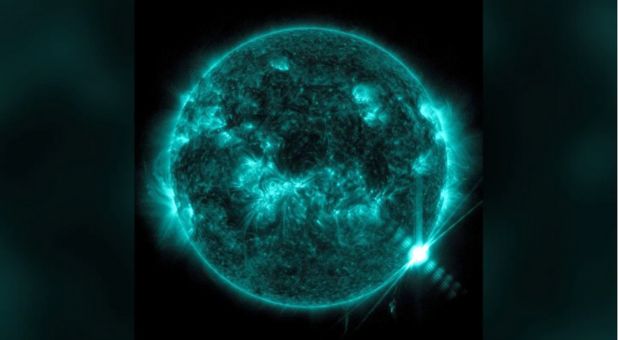NASA has identified a large cluster of sunspots or dark spots on the sun that have grown in size over the last month and could increase the risk of the Earth experiencing strong solar flares.
NASA found the sunspot cluster known as AR3576 in late January from photographs taken by NASA’s Perseverance rover on Mars, according to Fox News.
The magnetic fields of sunspots are thousands of times more powerful than Earth’s.
As CBN News recently reported, the sun’s surface is growing more active, and serious anomalies can happen when that takes place. While that’s great news for amateur astronomers who are set to see some amazing solar fireworks through their telescopes, it could be bad news for power grids and communication satellites circling the Earth.
Solar flares occur when magnetic energy builds up in the solar atmosphere and is released in an intense burst of electromagnetic radiation, according to Space.com.
This burst of energy can impact radio communications, electric power grids, navigation signals and pose risks to spacecraft and astronauts.
On Friday, NASA’s Sun and Space X account posted a video showing the sunspots. The spots are usually as large as the Earth. But AR3576 is more than 93,000 miles long or nearly four times the circumference of our planet and more magnetically complex.
Real-time images from NASA’s Solar Dynamics Observatory show an enormous sunspot group moving across the Sun right now!
— NASA Sun & Space (@NASASun) February 9, 2024
If you have eclipse glasses and good vision, you might be able to see it without magnification. (Never look directly at the Sun without proper eye protection!) pic.twitter.com/5clNZg6WKe
NASA also announced the sun released a strong solar flare on Friday. This flare was classified as an X3.3 flare. The agency classifies solar flares from the smallest or B-class, followed by C, M and X, the largest or most intense. The number following the letter signifies its strength.
Breaking News. Spirit-Filled Stories. Subscribe to Charisma on YouTube now!
Luckily, this time, Earth wasn’t in the solar flare’s path.
“Goodness knows how big this flare would have been if it had happened this side of the sun,” solar physicist Keith Strong wrote in a post on X.
But this doesn’t mean the Earth wasn’t affected. The X-class flare caused extensive radio blackouts. Traveling at the speed of light, the radiation reached Earth in just over eight minutes, causing shortwave radio blackouts on the sunlit portion of the planet, which included South America, Africa and the Southern Atlantic, according to Space.com.
The U.S. space agency on Sunday posted its weekly space weather report to X, along with a little more than three-minute video of the sun’s activity over the past week.
“Happy #SunDay!” NASA wrote. “This week’s space weather report includes:
· 4 C-class flares
· 20 M-class flares
· 19 coronal mass ejections
· 0 geomagnetic storms
Happy #SunDay! This week’s space weather report includes:
— NASA Sun & Space (@NASASun) February 11, 2024
· 4 C-class flares
· 20 M-class flares
· 19 coronal mass ejections
· 0 geomagnetic storms
This video from NASA’s Solar Dynamics Observatory (SDO) shows activity on the Sun over the past week. pic.twitter.com/CcsNcVfzGt
It’s the Coronal Mass Ejections (CME) that hurl charged matter out across the solar system like a giant shotgun, resulting in a potentially disruptive solar storm. {eoa}
Join Charisma Magazine Online to follow everything the Holy Spirit is doing around the world!
To read the original story, visit our content partners at CBN News.
Reprinted with permission from cbn.com. Copyright © 2024 The Christian Broadcasting Network Inc. All rights reserved.








































